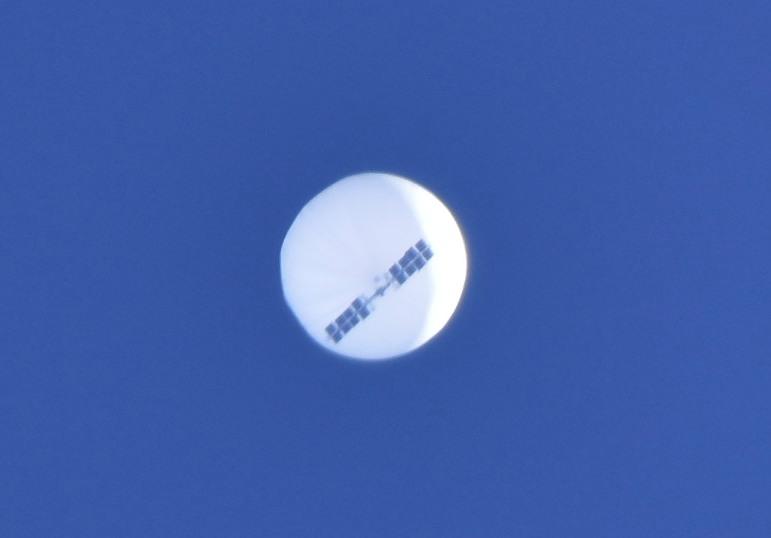Why Does the United States Have Balloon Hysteria?

The balloon drifts over Myrtle Beach shortly before the shoot-down on 4 February 2023. Image Courtesy: Wikimedia Commons
The news from the United States seems completely insane. First, it used an F-22 Raptor, its most expensive military aircraft, to shoot down a Chinese balloon over the Atlantic ocean. Three more “unidentified flying objects”—definitely not balloons—were shot down in three days, two over the United States and one over Canada. Asked whether they could be of extraterrestrial origin, Gen. Glen VanHerck, in charge of the North American Aerospace Defense Command (NORAD), said in a press conference: “I’ll let the intel community and the counter-intelligence community figure that out. I haven’t ruled out anything.”
I rubbed my eyes in disbelief. An American Air Force general, presumably not a UFO nutcase, is talking about the possibility of objects being shot down being of extraterrestrial origin! Or is it an attempt to focus the attention of the people and the media away from what was rightly the story of the week: Seymour Hersh’s account of the United States Navy sabotaging the Nord Stream 1 & 2 pipelines on the orders of President Joe Biden? Is it part of a new geopolitical tension the United States would like to ratchet up with China, or simply paranoia?
First, the Chinese balloon episode and the non-stop media coverage during its 7-day journey over the United States. From Biden to government spokespersons, the unanimous verdict was it was a sophisticated Chinese surveillance balloon “entrusted” with gathering data on important military installations in the United States. The “proof” was that the balloon had limited steering capabilities and could transmit data. Once the United States dredges up the remnants of the balloon from the shallow waters of the Atlantic coast, there is little doubt it will declare it has found “corroborative evidence” that this was indeed a surveillance balloon.
Among the many claims about the Chinese balloon, the United States government and the media have taken for granted that it was in the country’s airspace. Nor has China challenged this view. The problem here is that in international law, airspace is defined only in horizontal terms—airspace above the territorial water limit of 12 nautical miles belongs to the littoral country. But no such definition of sovereign airspace exists for the vertical territory of a country. In other words, any country can claim beyond, say, 60,000 feet (or 19.8 km), which should be considered international space. No country makes this claim only because it would also limit their sovereignty.
Is there a vertical limit—or height—from whereon we should consider space international, like international waters? Though there is no such agreement, almost every country considers that beyond the von Karman line at 100 km above ground the global commons, or no country’s airspace. The fuzziness lies in the space between 60,000 feet (19.8 km)—what is definitely a country’s airspace—and the von Karman line at 100 km.
Interestingly, the United States has a lower ceiling for space at 80 km, as its astronauts had initially managed only suborbital flights, unlike the Soviets, who, in April 1961, sent the first astronaut into full space orbit. The difference between Alan Shepard’s sub-orbital flight, which followed Yuri Gagarin into space, was that Shepard’s journey crossed the von Karman line but did not complete a full orbit above it and stayed only 15 minutes in space. Gagarin completed a full orbit around Earth and remained in space for 108 minutes. Though the United States beat the Soviets to the moon, on every other count, including the rockets, the Soviets were ahead. After the cold war, the United States used Russian rockets for space launches until very recently, as they were cheaper and had superior performance compared with United States rockets.
China has claimed the balloon the United States shot down after a 7-day media hysteria was a meteorological balloon. Is this claim credible, or was it indeed a surveillance balloon?
All countries use weather balloons to generate information. The United States launches 60,000 such balloons a year, and the world releases 1,800 daily! These balloons have instruments mounted to measure pressure, temperature, wind speed, relative humidity, etc., and send their measurements back via radio signals. That means all weather balloons have the ability to transmit measurements to their base stations. They also have limited ability to manoeuvre, at least vertically, and, given suitable air currents, even horizontally, so they can generate weather profiles over larger areas.
With this large number of balloons sent up every day, how come space is not littered with balloons? Once the weather balloon accomplishes its task—until it ruptures when it climbs to where its internal pressure is higher than the external pressure. However, a few balloons do fail to rupture and wander around in atmospheric currents as litter. Since air currents do not obey national laws, such balloon junk can travel across the globe and “violate” country boundaries.
Weather balloons are not the only kind. There are more sophisticated scientific balloons that carry many more instruments. They may also have limited means of navigation, like propellers and a small engine to power them. Though not cheap, they are far less expensive than satellites, the only other carriers of such instruments.
The United States claims the Chinese balloon is not an innocent weather balloon but possibly carried instruments to monitor its on-ground military sites. Why the Chinese would do that when they have military satellites in orbit to perform such missions is unclear. A recent Washington Post article has some evidence indicating unusual weather conditions could have blown the Chinese balloon off course.
The only advantage of balloons is they are much cheaper than satellites. But, surely, money is of little concern when strategic objectives—finding out what your adversary is doing—are involved. Strangely enough, while the United States breathed fire and brimstone on Chinese balloons, it had planned to use military surveillance balloons. Last year, Politico wrote a piece titled U.S. military’s newest weapon against China and Russia: Hot air, which notes, “The high-altitude inflatables, flying at between 60,000 and 90,000 feet, would be added to the Pentagon’s extensive surveillance network and could eventually be used to track hypersonic weapons.” In layman’s terms, inflatables are balloons, but since balloons do not sound so good when you are talking about war, the more impressive word is “inflatables”! Descriptions of the program make it sound impressive, but it has a budget of only $27.1 million for the 2023 fiscal year. For the Pentagon, where in 1986 toilet seats cost $640 and coffee-maker a cool $7,622, $27 million today is chump change.
But why the sudden findings, within one week, of one balloon and three unidentified flying objects, definitely not balloons? The answer lies not in much more surveillance activities by “hostile” powers but simply in the changes NORAD has made to the ability of its equipments to search for smaller objects and balloons. Earlier, they were configured to look for planes and missiles (larger objects or those with harder outer shells), not balloons or smaller objects. One NORAD official said it has opened the aperture wider, meaning it has started examining earlier disregarded shapes and sizes. One of these “objects” was most probably a $12 balloon used by the Northern Illinois Bottlecap Balloon Brigade, a hobby club. As a lot of these are air space litter or balloons over which the organisations launching them have lost control, the question is how do we deal with the resulting hysteria?
Also, I referred to the United States balloon program—is it doing what it is accusing China of? Sending up surveillance balloons for military purposes? If such balloons are indeed sent up, how can countries prevent them from going rogue and wandering into other countries’ ill-defined air space? Is it time to discuss the boundaries and the rules for air space, near space and outer space?
We can, but to address such issues, we require a very different climate, not military hysteria over balloons. Building up balloon hysteria is only one more step in the United States’ strategic vision to isolate Russia and China economically and surround them militarily. The other goal is to distract people from Seymour Hersh’s exposé of the Nord Stream sabotage.
Get the latest reports & analysis with people's perspective on Protests, movements & deep analytical videos, discussions of the current affairs in your Telegram app. Subscribe to NewsClick's Telegram channel & get Real-Time updates on stories, as they get published on our website.














